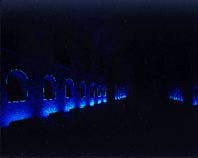|
|
|
|
|
|
||
|
Christina Kubisch Die Idee der Kunstsynthese Helga de la Motte-Haber CLICK: deutsch |

"DAY AND NIGHT" Installation in "De Vleeshal", Middelburg, NL 1993 Christina Kubisch was educated both as a visual artist and musician, she studied at the art academies of Bremen and Stuttgart and the music conservatories at Hamburg, Zürich and Milan. The fusion of the visual with acoustic has influenced all of her works, as diverse as they may be from one another. While the focus of her artistic activity at first lay in the field of music, space had already played a large role in one of her first compositions, Language in Progress (1974). In this piece, which was conceived for 16 voices a cappella, vocalists were positioned in four groups around the audience. In numerous performances of the 1970's (some of these in collaboration with the video artist Frabrizio Plessi), spatial asp... and/or the movement of the audience in the room were just as important as the unusual sounds. During these years, Christina Kubisch appeared as the interpreter of her own pieces. In Emergency Solos (1975), she played the flute in many different ways, among others with thimbles, leather gloves, gas masks or just the mouthpiece.
In these early works, the correlation between the visible and the audible is taken for granted. Indeed, this visual music does not belong to any category of art. It developed in that border area between instrumental music and music theater. At the same time technical innovations were also seized upon and explored artistically. A departure from the .. .. artworld was signalized. Inherent to these works is a mistrust of the arbitrarily ... borders between the arts, borders that have their origins in classicist acsthetics.
In the works of Christina Kubisch, it becomes fundamentally clear how the genre
of the sound installation developed from performance art by condensing
multi-dimensional actions into different installation art forms. About 1980,
the transition in Kubisch's work from performance to sound installation was
completed (Ohne Titel - "Untiteld" - 1981). The artist retired from
performing and relinquished this role entirely to the audience.
Rooms and landscapes were covered with cables to become soundpaths, routes,
tents, surfaces and sculptures. With the aid of two cube-shaped receivers, the
visitor could listen to sounds in the cables (through electromagnetic
induction) and follow them in space. In Magnetischer Wald "Magnetic Forest"
(1983) yellow - green electric cables (that matched the
surroundings) were laid between trees and around the trunks. Depending upon
where one moved with his cubes, one entered into another natural space that ...
and chirped as if in dialogue with the people. Beginning 1984, Kubisch used
headphones and in1987 proceeded to work with "open" sounds emanating from
loudspeakers.
Not only idea of fictional spaces, but also the idea of fictional nature almost always plays a large role in the works of Christina Kubisch. This is not only true for the installations in forests, parks and gardens, but also for the repetitive structures of her acoustic compositions which seem to be natural sounds, and in recent works, are partly created from natural sounds. The transitions between the artificial and the natural are fluid. The Konferenz der Bäume - "Converence of the Trees" - (1989) displays five real bonsai trees on a table with the aid of headphones, one can take part in their murmuring conference, leaving the real world at the same time. Like blossoms from the interior of the sediment cauldron of a brewery (Kreisläufe - "Circulations" - 1993), pigmented loudspeakers glowed. They were controlled by solar cells affixed to the outside. The sound changed according to the light of day and night. As in Passagen II - "PassagesII" (1994), the artificial flowers needed natural light in order to reveal their speech. Regarding the "Passages". Christina Kubisch noted that they are like a picture made of light that is acoustically perceptible and at the same time, reminds one of a drawing in a botany book. Repoductions of nature are created as if their originals existed only in fantasy. For Passagen III - "Passages III" (1995) "natural" sounds were used without any sort of electronic disortion. These sounds (on six tracks) come from vibrating glass and have the effect of making a glowing flower appear breakable. The fictions form of the plant appears as a symbol of nature whose immediate perception is not (or not any more) possible. But this nature sill appears to be perceivable through art. Many works by Christina Kubisch show that whatever people can comprehend from their enviroment always carries the traces of their interference.
Helga de la Motte-Haber English translation
Laurie Schwartz
|
|
|
|
||